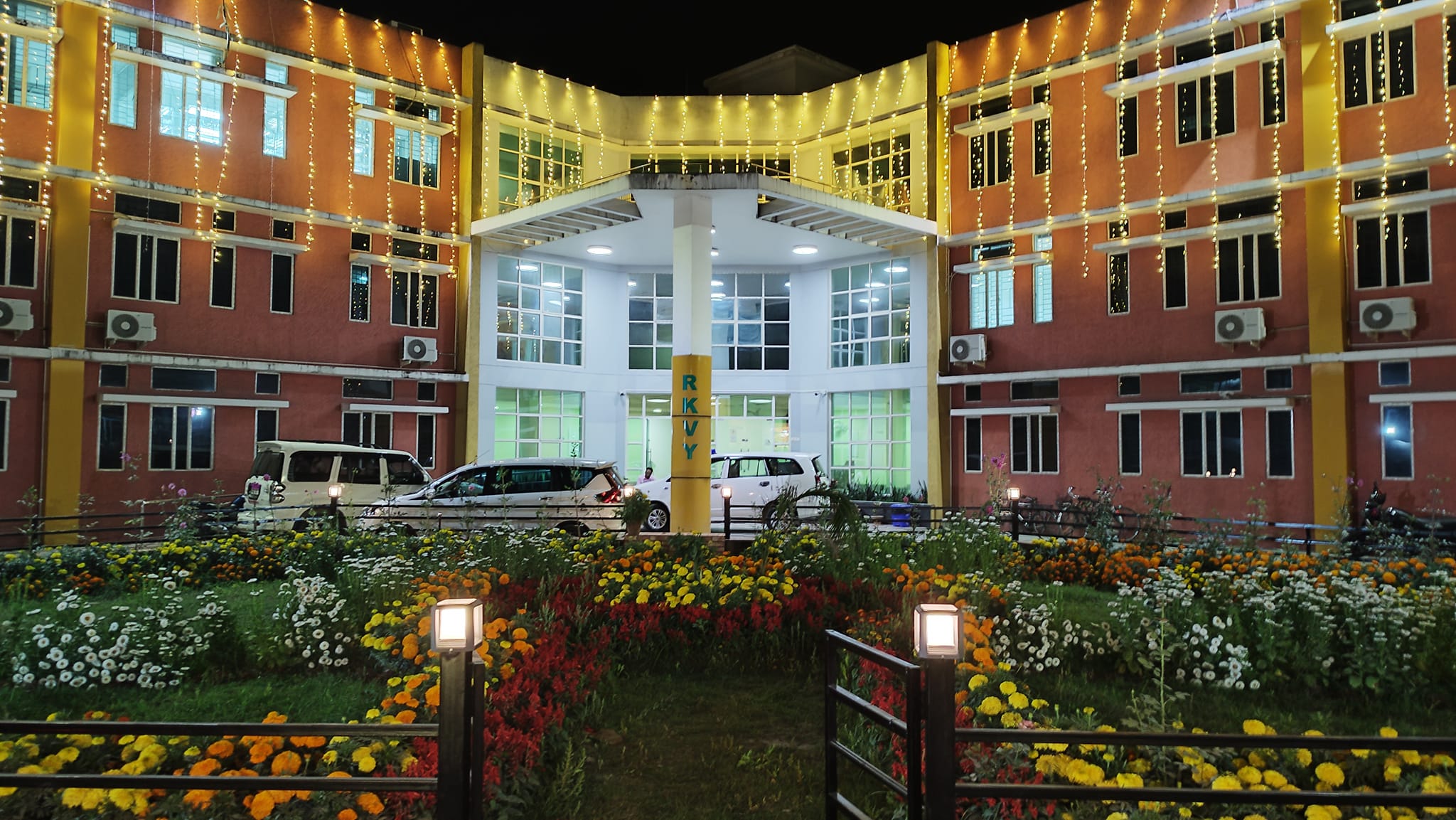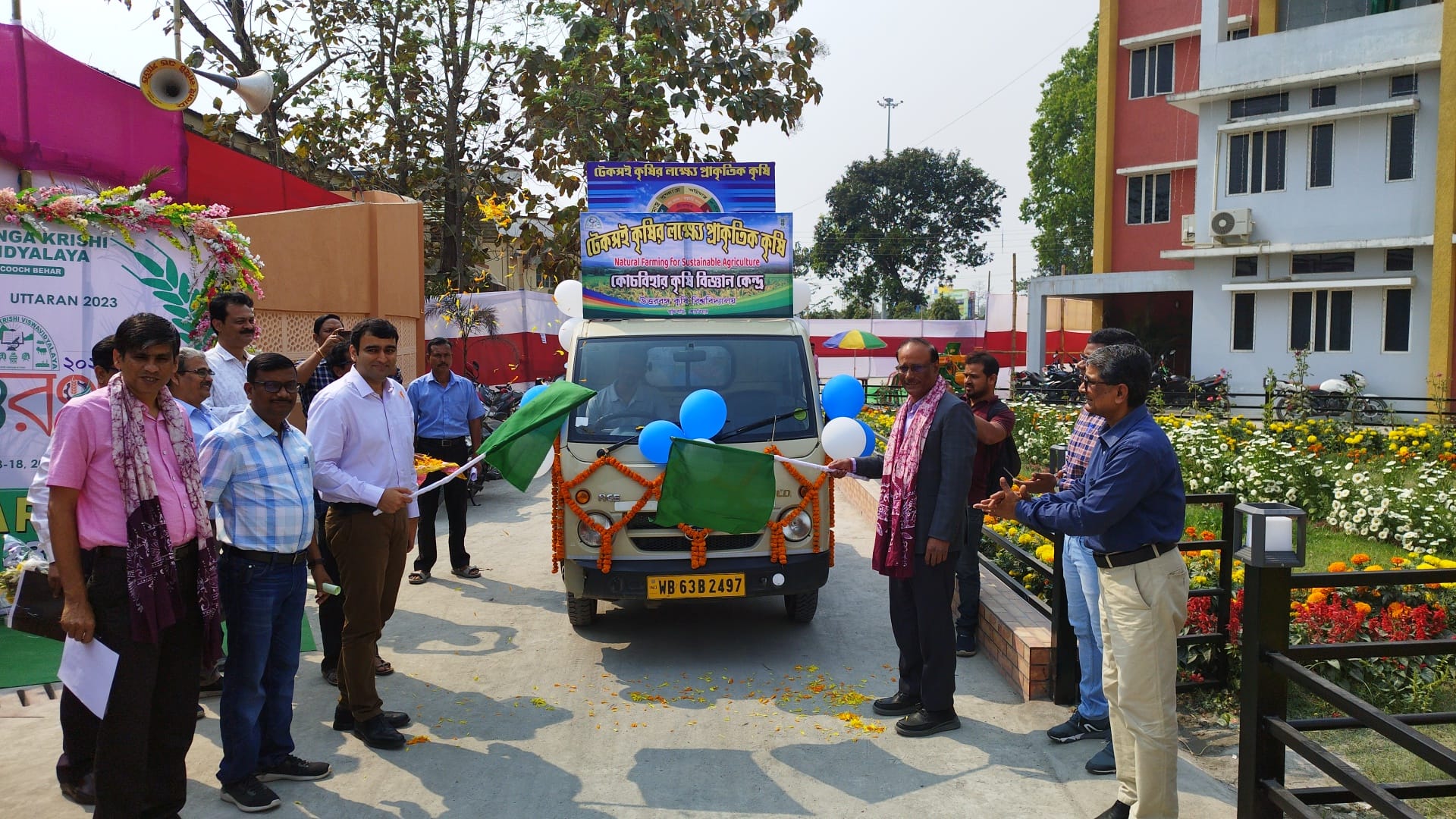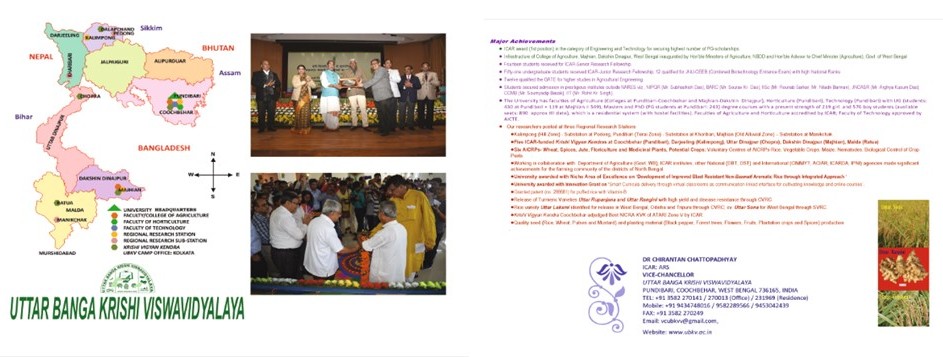Uttar Banga Krishi Viswavidyalaya Seed Policy 2020
A. Crop Improvement :
1. Rice
UBPS 3 (IET 20321) – Kharif
Very early Maturing (109 days) may be used for contingent planning in flood prone areas, disease Resistant, slender Grain, Grain quality comparable to basmati, very high tiller number (455/sq m), 4.2-4.5 t/ha yield
UBPS 1 (IET 20156) – Boro
Early maturing (124 days), Disease resistant, slender grain, quality comparable to basmati, 4.5-5.2 t/ha yield
2. Wheat
- Selection of terminal heat tolerant varieties for late (15th December) and very late (30th December) sown conditions in collaboration with CIMMYT
- Selection of genotypes for tolerance to Boron Defficiency
- Selection of Foliar Blight resistant genotype in collaboration with CIMMYT.
3. Turmeric
- Suranjana : Disease tolerant, high yielding, high curcumin content
B. Crop Production Enhancement:
1. Standardization of Sri Method for More Rice Production
Saving of cost on seed, fertilizer and water, nservation of natural resources and high yield performances are recorded.
2. Direct Seeded Rice with Brown Manuring Using Dhaincha
Reduces labour, fuel and water requirements and thus production cost is less in ZT DSR (approx. Rs. 2500 ha-1 ); 12 to 15% reduction in cost of cultivation thus increasing the Benefit-Cost Ratio from 1.5 to 2.5
A net return of Rs. 13,500/- per hectare can be obtained in zero tillage direct seeded rice cultivation as against Rs. 8,000/- for conventional tillage situation and also saves the crop in low rainfall years.
3. Zero Tillage Wheat
Late planting of wheat may be avoided and saves time, labour, fuel and irrigation water thus reduce the cost of cultivation to about 20%.
4. Zero Tillage (Hybrid) Winter Maize
22-25% reduction in cost of cultivation is recorded.
5. Potato + Maize (Hybrid) Intercropping
About Rs 23,000/- per hectare extra net return over sole potato is achievable and maize acts as a compensation crop in case of late blight epidemic.
6. Technology to Reduce Arsenic Contamination in Rice Produce
Intermediate ponding of the crop and application of organic matter in form of green manuring by lathyrus @ 5t/ha in addition to vermicompost @ 2.5t/ha and poultry manure @ 2.5t/ha. Utilizing the genotypes Swarna and Dharya are better as they mine less arsenic from the soil.
7. Use of Leaf Colour Chart (LCC) as an Efficient Tool for Need Based Nitrogen Application in Rice
8. Integrated Package for Production of Green Gram (SML 668) and Cowpea (CP-4)
The package has been developed by using Rhizobium (URH 3) and Phosphate solubilizer (UBPS 9) for production improvement of green gram and cowpea at reduced level of chemical fertilizer under zero-tillage condition using punch planter.
9. Lime Dressing of Blackgram Seeds for Acid Soils :
Lime powder sprinkling and Rhizobium application of seed is beneficial
10. Introduction of Faba Bean as Paira Crop in Rice-Based Cropping System
In rice-faba bean system, sowing of Faba bean may be done 15 days before rice harvest.
11. Effective Mode and Dose of Application of Molybdenum for Ground Nut in
Over night seed soaking with molybdenum@ 25 ppm/kg of seed (i.e. 250 mg Sodium molybdate/ litre of water/ kg of seeds) is most effective in increasing nodulation and ultimate yield of ground nut .
12. Commercial Production of Enriched Phospho-Compost
In the phosphocompost preparation wheat straw, fresh cow dung and the mixed green biomass (viz. weed Polygonum spp. and Micania micrantha) are used in the ratio of 7: 2:1 on dry weight basis. Fresh wheat straw is chopped in 2-3 inch size. For making the heap of 50 kg dry biomass, 60.345 kg fresh wheat straw, 50 kg fresh cow dung, 22.88 kg green biomass of weeds (fresh Polygonum and Micania) are required. Cellulolytic micro-organism (Trichoderma viridii) applied @ 20 gm heap-1 and phosphate solubilizing bacteria (PSB-9) applied @ 50 gm heap-1 after mixing with the slurry is most suitable.
13. Refinement of Jute Production Technology Package
Substitution of nitrogenous fertilizers with organic compost to the tune of 50% particularly with Farm yard manure followed by Glyricidia compost with pre emergence application of Trifluralin @0.75kg a.i./ha at 1 day back of sowing is shown exhibited highest potential Maximum net return can be obtained if jute is intercropped with red amaranthus which is harvested at the time of first weeding.
14. Retting Technology for Quality Fibre in Jute
Use of plastic cover particularly with white polythene on the submerged jute bundles during retting helps in getting improved quality fibre.
15. Buckwheat as Paira Crop in Rice-Based Cropping System
In Rice-Buckwheat cropping system, sowing of Buckwheat is remunerative.
16. Integrated Nutrient Management of Okra
Application of vermicompost (5t/ha) along with 75% recommended dose of nitrogen and full dose of phosphorus and potash (RDF-100:60:60 kg N P K/ha) inoculated with Azotobacter can be practised for okra.
17. Integrated Nutrient Management of Green and Seed Production of Palak
Application of vermicompost (5t/ha) along with 50% recommended dose of nitrogen and full dose of phosphorus and potash (RDF-100:50:50 kg N P K/ha) inoculated with Azotobacter can be practiced for maximum green yield of palak cv Pusa Bharati
18. Integrated Nutrient Management of Chilli Using Biofertilizers.
Dual inoculation with the biological nitrogen fixers Azotobacter and Azospirillum along with 75% recommended dose of N-fertilizer @ 80kg N/ha and farmyard manure @ 15tonnes/ha increase yield and quality parameters.
19. Agro-Technique for Cauliflower Seed Production
The agro-technique has been developed.
20. Intercropping of French Bean and Pea in Newly Developed Banana Orchard
This interspace can profitably be used for raising crops like french bean and garden pea which fetches an additional income to the farmers, helps in weed management and increases soil health.
21. Round the Year Pointed Gourd Production in the Betelvine Boroj
Pointed gourd can be taken as intercrop inside betelvine boroj to get an additional yield and income.
22. Osmotic Dehydration of Pineapple
Optimum operating condition: Optimum condition in sucrose solution was found to be 50 per cent (w/w) concentration, 200 min process time and 32.15oC process temperature while the optimum condition in invert sugar solution was 47.46 per cent (w/w) concentration, 158.28 min process time and 30oC process temperature. The optimum condition in sorbitol solution was found to be 35.40 per cent (w/w) concentration, 200 min process time and 30.94oC process temperature.
23. Coconut Based High Density Multi-storey Cropping Systems (CBHDMS)
Coconut based high density multistorey cropping systems (CBHDMS) with various crops combinations have been established.
Crop Model-I: Coconut + Pineapple + Gladiolus + Amaranthus.
Crop Model –II: Coconut (Monocrop)
24. Arecanut Based High Density Multi-storey Cropping Systems (ABHDMS)
Out of 6 models of arecanut based high density multistorey cropping systems (ABHDMS) the model interplanted with (a) banana (Giant governor), papaya, lemon, turmeric and pineapple and (b) banana (Malbhog), papaya ,bean, cowpea are best remunerative upto 4 years.
25. Carbon Sequestration Through Agroforestry
Carbon sequestration potential of disturbed land viz. fallow land and agriculture field is only 5.86 and 4.73 % respectively as compared to natural forest of S. robusta. However, agroforestry systems viz. tea garden and agri-horticulture agroforestry systems contributed 24.24 and 9.09 % carbon whereas pure plantation of D. sissoo and T. arjuna contributed 31.59 and 23.93 % carbon respectively as compared to natural forest of S. robusta.
26. Growth Media for Terrestrial Orchid (Cymbidium Hybrid)
Combination the growing media prepared by mixing loamy soil, coconut fibre and cocopeat in the ratio of 1:1/2:1/2 are found most suitable.
27. Growth Media for Epiphytic Orchid (Aerides Odoratum)
The media has been developed.
28. Nutrient and Growth Regulators for Orchid (Cymbidium elegans)
The terrestrial orchid Cymbidium elegans can be grown with a combination of NPK -30:10:10- 0.2% and BA@ 100 ppm.
29. Improving Vase Life Using Suitable Holding Solution (Cymbidium hybrid)
The holding solution consisting AgNO3 (25 ppm) + HQ (400 ppm) + Sucrose (5%) gives prolonged vase life to the orchid.
30. Rapid Method for Large Scale Production of Nucellar Seedlings Darjeeling Mandarin (Citrus reticulate Blanco.)
The protocol for nucellar seedlings has been standardized.
31. Conservation Of Valeriana jatamansi : A High Value Medicinal Herb In Darjeeling Hills
It adapts well between 1200m and 2200m altitudes starting from the mid hill forest area to high range of Darjeeling Himalayan range.
- Locally it is being used for medicinal purpose especially for headache and eye trouble.
- In Ayurvedic medicine, it is used as aromatic, stimulant, carminative, and antispasmodic.
32. Conservation of Highly Endangered Medicinal Herb Swertia chirayita in Darjeeling Hills
Package of practice has been developed to different kind of Swertia sp. observed in Darjeeling himalayan range having an altitude between 2500-3600 m. (5000-7000ft above sea level).
33. Emphasis on cultivation and propagative material production of medicinal plants important for the region
Emphasis given on cultivation of Stevea at hill zone
34.Bio-technical Intervention for Conservation of Endangered Medicinal Plants
Micropropagation protocol of a high altitude, high medicinal valued (varying picroside content), endangered habitat of Eastern Himalayas has been developed.
35. Winter green oil (Gaultheria fragmentisiima): A rare essential oil yielding plant of India
Micropropagation and DNA finger printing has been done of high altitude woody essential oil bearing endangered plant of Eastern Himalayas, major constituent of Aspirin tablets
34. Integrated Nutrient Management for Ginger and Turmeric
Application of 20 t/ha FYM with half dose of fertilizer N, P, K (60:60:60), in presence of Azospirillum and P-solubilizers, seed treatment with Trichoderma and fluorescent pseudomona, drenching with Bordeaux Mixture @ 0.5% and Malathion @ 0.1% at 21 days interval from July onwards with onset of monsoon Increase in yield by 57-60% and 18-20% in ginger and turmeric respectively and enhance in quality of the produce with high oleoresin (3.7% in ginger and 9.6% in turmeric).
C. Crop Protection :
1. First Report of Zonate Eye Spot in Wheat from India
- Small, distinct, eye shaped spots of light grey colour with dark brown margin
- Appears late in the season after spot blotch of wheat
- Caused by Drechslera gigantea
2. Standardization of IPM Module for Rice:
Selection of physiologically mature seeds, hot water seed treatment @ 52oc for 15 min followed by bio-control agents, spraying with Imidichloprid 0.03% + Tricyclozole 0.05% in nursery bed before three days of transplanting and application of Fipronil 0.3 G @ 20-25 kg ha-1 in main field at 25 DAT, Burning the tyre in the bund @ 100 nos./ha in the evening as light trap every 7 days interval, Securing bird perches at 80-100 nos./ha, Cow dung slurry 20% spray for BLB & BLS and Snail bait trap (50 gm flesh/trap with insecticide) for rice Gandhi bug.
3. Standardized Protocol for Integrated Management of Rice Diseases
Seed Treatment: Carbendazim (0.1%) + Mancozeb (0.2%), Seed Bed Treatment with Hexaconazole / Carbendazim (0.1%) followed by spray with Hexaconazole / Carbendazim (0.1%) at PI stage or Plantamycin @ 1.5 g/l of water manage the disease..
4. Standardized Protocol for Integrated Disease Management of Foliar Blight of Wheat
Use of tolerant varieties, seed treatment with Vitavax or thiram and foliar application with propiconazole/ tebuconazole reduce the disease by 15%.
5. Integrated Management of Bacterial Wilt of Solanaceous Crops
Soil solarization with polythene sheet and soil application of lime and green manuring with bio-control agents coupled with Bleaching powder reduce the disease considerably..
6. Eco-Friendly Management Module of Brinjal Fruit and Shoot Borer:
By application of Pheromone trap, Neem cake and neem oil enhances the B:C ratio.
7. Management of Rhizome Rot of Ginger:
Hot water treatment of seeds and soil application of Trichoderma harzianum
Reduce the disease upto 37% and increase yield by 40%..
8. ManagementofLeaf Blotch and Leaf Spot of Turmeric:
Seed treatment as well as spraying with Mancozeb + Carbendazim (0.2% + 0.2%).
9. Management of Rhizome Rot of Turmeric:
Seed treatment with Trichoderma viride and Pseudomonas fluorescens and Soil application of Trichoderma viride and Pseudomonas fluorescens @12.5 kg /ha and 25.0 kg /ha as basal and top dressing respectively increase the yield upto 42%.
10. Integrated Management of Pythium, Fusarium and Ralstonia of Ginger:
Soil application of Trichoderma harzianum and neem cake and seed treatment with Trichoderma followed by mancozeb spray reduce the disease upto 68%.
11. Integrated Pest and Disease Management of Jute
The management package includes resistant varieties, bioagents and chemicals. This practice reduces the cost of cultivation and enhances the yield and quality of fibres.
12. Production of Bio-Primed Seedlings at Village Level Nurseries
Value added vermicompost (mixed with Trichoderma and Fluorescent pseudomonas) applied to soil @ 1kg/m2 in beds (1m x 3m) with SSP @ 35g /m2 OR mixing of the same with soil in the ratio of 1:3 and raise seedlings in portrays.
13. Mass production technology of Trichoderma
The mass production technology has been standardized in sago and broken wheat grains (dalia) with 1% chitin and diluting it with talc for further use.
14. Solid Matrix Bio-Priming for Vegetable Seedling Production
- 0.2 kg bio- agent formulation in talc for 1kg seed with 0.25 kg molasses or 200 ml jaggery; incubated for 2 days at 28ºC.
- Seeds are sown in portrays or in beds in lines according to the crop.


















